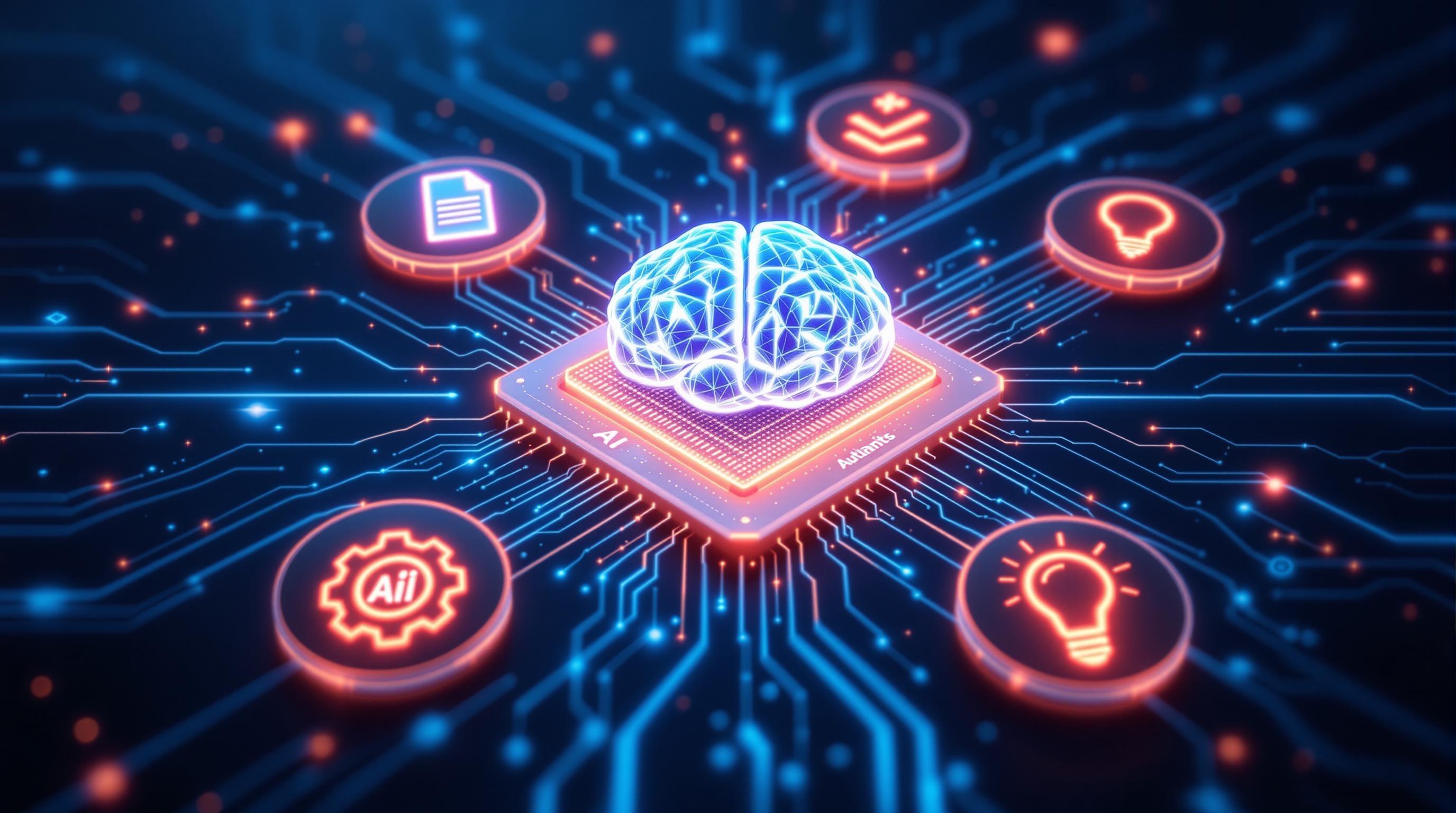AI Writing Revolution: Choosing the Best Tools to Supercharge Your Content

The Rise of AI in Writing: Enhancing Creativity and Productivity
The world of writing is undergoing a seismic shift, and at the heart of it all lies Artificial Intelligence. AI writing tools, once a futuristic concept, are now indispensable assets in the content creation landscape, helping both novice and seasoned writers alike.
Unleashing the Power of AI in Writing
AI writing tools are software applications that leverage natural language processing (NLP) and machine learning to generate text, assist with editing, and enhance the overall writing process. These tools are rapidly gaining prominence for a multitude of reasons. They offer unprecedented speed and efficiency, allowing writers to produce more content in less time. They can also spark creativity by suggesting new ideas and perspectives, or help maintain a consistent brand voice across all your materials. It's like having a tireless, always-available writing partner.
Consider the sheer volume of content being created daily – blog posts, articles, social media updates, marketing copy, and more. AI writing tools step in to streamline these processes, offering features like:
Automated Content Generation: Produce drafts quickly based on given keywords or topics.
Grammar and Style Checking: Ensure error-free and polished writing.
Content Optimization: Enhance readability and SEO performance.
Idea Generation: Overcome writer's block with AI-powered suggestions.

Benefits Beyond Measure: Efficiency, Creativity, and Consistency
The benefits of integrating AI into your writing workflow are substantial. Efficiency is perhaps the most immediately noticeable. Tasks that once took hours can be completed in minutes, freeing up valuable time for other strategic initiatives. Furthermore, AI can act as a powerful muse, pushing creative boundaries and helping writers explore uncharted territories. Imagine struggling with an introduction; an AI tool can offer several compelling options, jumpstarting your thought process. Finally, for businesses striving for a unified brand identity, AI ensures consistent messaging across all channels, maintaining a professional and cohesive image.
Debunking the Myth: AI as a Collaborative Partner, Not a Replacement
A common misconception is that AI will replace human writers altogether. However, the reality is far more nuanced. AI should be viewed as a powerful assistant, augmenting human capabilities rather than supplanting them. Human writers bring critical thinking, emotional intelligence, and creativity to the table – qualities that AI, in its current form, cannot fully replicate. For example, while ChatGPT can generate text based on prompts, it still requires human oversight to ensure accuracy, relevance, and originality. The best approach involves leveraging AI to handle repetitive tasks and generate initial drafts, while human writers refine, personalize, and inject their unique voice into the content.
From Simple Grammar Checks to Sophisticated Content Creation
The evolution of AI writing tools has been nothing short of remarkable. Early tools primarily focused on basic grammar and spell-checking. Today's AI-powered platforms can perform complex tasks such as:
Generating diverse content formats: From blog posts and articles to social media captions and email marketing campaigns.
Optimizing content for SEO: Identifying relevant keywords and improving search engine rankings.
Personalizing content: Tailoring messages to specific target audiences.
Summarizing long-form content: Condensing large amounts of text into concise summaries.
These capabilities are constantly expanding, driven by advances in machine learning and natural language processing.
Making the Right Choice: Factors to Consider When Selecting an AI Writing Tool
With a plethora of AI writing tools available, selecting the right one can feel overwhelming. Here are key factors to consider:
Use Case: What specific writing tasks do you need assistance with? Are you primarily focused on content generation, grammar checking, or SEO optimization? Identify your core needs to narrow down your options. For instance, if you need to generate high-quality images to accompany your writing, you might consider using Adobe Firefly.
Budget: AI writing tools range from free, basic versions to expensive, enterprise-level platforms. Determine your budget and look for tools that offer the best value for your investment.
Features: Evaluate the features offered by each tool. Does it support the content formats you need? Does it integrate with your existing workflow? Does it offer customization options to align with your brand voice?
By carefully considering these factors, you can confidently choose an AI writing tool that empowers you to create exceptional content, boost productivity, and achieve your writing goals.
As AI writing tools continue to evolve, they will undoubtedly play an even greater role in shaping the future of content creation. The key is to embrace these technologies strategically, recognizing them as valuable partners that can enhance human creativity and productivity, not replace them. Next, we'll delve into the specific features and capabilities that make AI writing tools so powerful, exploring the options that are at your disposal.

Top AI Writing Tools: A Detailed Comparison
Choosing the right AI writing tool can feel like navigating a maze, but understanding the strengths and weaknesses of each option makes the decision much easier. Let's dive into a detailed comparison of some of the top contenders in the AI writing space.
ChatGPT: The Versatile All-Rounder
ChatGPT, developed by OpenAI, has become synonymous with AI writing. It excels at a wide range of tasks, from generating blog posts and social media content to drafting emails and even writing code.
Strengths:
Versatility: Handles diverse writing tasks with ease.
Natural Language: Produces text that often sounds remarkably human.
Interactive: Allows for iterative refinement through conversation.
Weaknesses:
Hallucinations: Can sometimes generate inaccurate or nonsensical information. (Be sure to read our article on AI gaslighting to learn more!)
Bias: May exhibit biases present in its training data.
Creativity Limitations: While proficient, it may lack true originality.
Pricing: ChatGPT offers a free version with limited access and a paid subscription (ChatGPT Plus) for enhanced features and priority access during peak times. For professional use, consider OpenAI Academy.
Use Case: A marketer could use ChatGPT to brainstorm content ideas, draft social media posts, and create email marketing campaigns.
Ideal User: ChatGPT is suitable for a broad range of users, including marketers, bloggers, students, and anyone needing assistance with writing tasks.
Google Gemini: Google's Ambitious Challenger
Google Gemini is Google's answer to OpenAI's dominance. Integrated across Google's ecosystem, Gemini aims to provide seamless AI assistance for various writing and creative tasks. Check out the latest on Gemini Ultra.
Strengths:
Integration: Seamlessly integrates with Google Workspace apps like Docs and Gmail.
Contextual Awareness: Leverages Google's vast knowledge graph for better understanding.
Multimodal Capabilities: Can process and generate text, images, and audio.
Weaknesses:
Availability: Wider roll-out is gradual.
Accuracy: Like other LLMs, Gemini can produce inaccurate information.
Bias: May exhibit biases present in its training data.
Pricing: Google Gemini offers a free tier and a paid subscription (Gemini Advanced) for access to more advanced features and capabilities.
Use Case: A student could use Google Gemini to research topics, summarize articles, and draft essays directly within Google Docs.
Ideal User: Google Gemini is ideal for students, researchers, and professionals who heavily rely on Google's suite of applications.
Claude: The Safety-Focused Writer
Claude, developed by Anthropic, emphasizes safety and ethical considerations in AI. It's designed to be helpful, harmless, and honest, making it a reliable choice for sensitive writing tasks. Be sure to check out the latest iteration, Anthropic Claude 37.
Strengths:
Safety: Prioritizes ethical considerations and avoids generating harmful content.
Reasoning: Demonstrates strong reasoning and problem-solving skills.
Context Window: Boasts a large context window for handling complex and lengthy prompts.
Weaknesses:
Creativity: May be less creative than other AI writing tools.
Availability: Not as widely available as other popular options.
Pricing: Claude offers a free tier and a paid subscription (Claude Pro) for enhanced features and priority access.
Use Case: A legal professional could use Claude to review contracts, summarize legal documents, and draft legal briefs, ensuring accuracy and ethical compliance.
Ideal User: Claude is well-suited for professionals in regulated industries, such as law, finance, and healthcare, where safety and compliance are paramount.

Copy.ai: The Marketing Specialist
Copy.ai is specifically designed for marketing and advertising purposes. It offers a wide range of templates and tools to help marketers create compelling copy for various channels.
Strengths:
Marketing Focus: Tailored for marketing and advertising use cases.
Templates: Provides a library of templates for various marketing tasks.
Ease of Use: User-friendly interface for quick content generation.
Weaknesses:
Limited Versatility: Not as versatile as general-purpose AI writing tools.
Quality: Output quality can vary depending on the prompt and template used.
Pricing: Copy.ai offers a free plan with limited credits and paid subscriptions for increased usage and features.
Use Case: A ,social media manager could use Copy.ai to generate ad copy, write social media captions, and brainstorm content ideas for different platforms.
Ideal User: Copy.ai is ideal for marketers, advertisers, and entrepreneurs looking to streamline their content creation process.
Grammarly: The Grammar Guardian
While primarily a grammar and spell checker, Grammarly has expanded its AI capabilities to include writing assistance features such as tone detection, style suggestions, and sentence rewriting.
Strengths:
Grammar and Spelling: Provides accurate and reliable grammar and spelling checks.
Style Suggestions: Offers suggestions to improve writing style and clarity.
Integration: Integrates seamlessly with various writing platforms and applications.
Weaknesses:
Limited Content Generation: Not designed for generating long-form content from scratch.
Cost: Advanced features require a paid subscription.
Pricing: Grammarly offers a free version with basic grammar and spelling checks, and a premium subscription for advanced features and suggestions.
Use Case: A student could use Grammarly to proofread essays, check grammar and spelling, and improve writing style before submitting them.
Ideal User: Grammarly is suitable for students, writers, professionals, and anyone who wants to improve their writing skills and ensure error-free content.
Feature and Pricing Comparison Table
Feature | |||||
|---|---|---|---|---|---|
Long-Form Content | Yes | Yes | Yes | Limited | No |
SEO Optimization | Limited | Limited | Limited | Yes (Marketing Focused) | No |
Grammar Checking | Yes (Basic) | Yes (Basic) | Yes (Basic) | Yes (Basic) | Yes (Advanced) |
Creative Writing | Yes | Yes | Limited | Yes | No |
Free Plan | Yes (Limited) | Yes (Limited) | Yes (Limited) | Yes (Limited) | Yes (Basic) |
Subscription Cost | $20/month | $20/month | $20/month | Varies | Varies |
Ultimately, the best AI writing tool depends on your specific needs and priorities. By carefully evaluating the strengths and weaknesses of each option, you can choose the tool that will best help you supercharge your content creation process. If you want to dive even deeper, head over to our AI News section to keep up with the very latest developments.
Boosting Your SEO with AI-Powered Writing
Want to climb the search engine ranks and attract more organic traffic? AI isn't just about writing; it's about writing smart for SEO. Let's explore how you can leverage AI to supercharge your content's visibility.
AI Tools for SEO Domination
Several AI tools stand out for their SEO prowess, integrating features that go beyond just generating text. For example, you can utilize Surfer, a tool designed to elevate your SEO game through AI-driven insights and content optimization.
Here are a couple of examples of other tools known for their SEO capabilities:
INK Editor: This AI writing tool emphasizes SEO from the ground up. It analyzes your content in real-time, providing suggestions for keyword usage, readability, and overall SEO score. It’s like having an SEO expert looking over your shoulder as you write.
SEMrush Writing Assistant: While SEMrush is a comprehensive SEO platform, its Writing Assistant provides detailed feedback on your content's SEO potential. It considers factors like keyword density, target keywords, readability, and tone of voice to help you create high-ranking content.
Mastering Keyword Research with AI
Keyword research is the bedrock of any successful SEO strategy. AI can automate and enhance this process, helping you uncover hidden opportunities and target the most relevant terms. Instead of manually sifting through keyword data, AI algorithms can analyze vast datasets to identify:
Trending keywords: Discover what people are searching for right now.
Long-tail keywords: Target niche queries with high conversion potential.
Competitor keywords: See what keywords your rivals are ranking for.
With tools like Google Cloud AI, you can analyze search trends and identify emerging topics, giving you a head start in creating content that aligns with user intent. Remember to also check out AI News for any new advancements in AI-powered SEO techniques.

Content Optimization: AI to the Rescue
Creating great content is only half the battle. You also need to optimize it for search engines. AI can assist with various aspects of content optimization, including:
Keyword Placement: AI tools can suggest optimal keyword placement within your content, including in titles, headings, and body text. This ensures that search engines understand the topic of your content and its relevance to specific search queries.
Semantic SEO: AI can analyze the semantic relationships between words and phrases, helping you create content that is not only keyword-rich but also semantically relevant. This means that your content will be more likely to rank for a wider range of related keywords.
Content Structure: AI can analyze the structure of your content and suggest improvements to enhance readability and user experience. This includes breaking up long paragraphs, using headings and subheadings effectively, and incorporating visuals to engage readers.
Beating the Competition with AI-Powered Analysis
Understanding your competitors' strategies is crucial for outranking them in search results. AI can automate competitive analysis, providing insights into:
Keyword Gaps: Identify keywords that your competitors are ranking for but you aren't.
Content Performance: Analyze the performance of your competitors' content, including social shares, backlinks, and engagement metrics.
Backlink Analysis: Discover where your competitors are getting their backlinks from.
By analyzing these factors, you can identify opportunities to improve your own SEO strategy and create content that is more likely to rank higher than your competitors'.
Readability and Engagement: The AI Advantage
Search engines prioritize content that is easy to read and engaging for users. AI can help you improve these aspects of your content by:
Simplifying Complex Language: AI can identify complex sentences and suggest simpler alternatives.
Improving Grammar and Spelling: AI-powered grammar checkers can catch errors that you might miss.
Adding Visuals: AI tools can suggest relevant images and videos to enhance the visual appeal of your content. For example, you could use a tool like Midjourney, a powerful AI image generator known for its artistic and photorealistic results, to create stunning visuals.
Crafting SEO-Friendly Metadata with AI
Metadata, such as headlines, meta descriptions, and alt text, plays a crucial role in SEO. AI can help you optimize these elements to improve your content's visibility in search results:
Headline Optimization: AI can suggest compelling headlines that include relevant keywords and entice users to click.
Meta Description Generation: AI can generate concise and informative meta descriptions that accurately summarize the content of your page.
Alt Text Creation: AI can automatically generate descriptive alt text for images, making them accessible to visually impaired users and improving your site's SEO. Tools like Jasper, an AI writing and content creation platform, can assist in this process by generating multiple variations of meta descriptions and alt text, allowing you to choose the most effective options.
SEO Scoring with AI: Track Your Progress
Some AI writing tools come with built-in SEO scoring features that allow you to track your progress and identify areas for improvement. These scores typically take into account factors such as keyword density, readability, and content length. By monitoring your SEO score, you can ensure that your content is optimized for search engines and make data-driven decisions to improve your rankings.
Remember: While AI can be a powerful tool for SEO, it's essential to use it ethically and responsibly. Avoid keyword stuffing, plagiarism, and other black-hat SEO tactics that can harm your site's reputation.
By embracing AI-powered writing, you can elevate your SEO game and create content that not only resonates with your audience but also ranks high in search results. Now that you're armed with the knowledge to optimize your content, let's dive into how AI can revolutionize your content creation process.
Unleashing Creative Potential: AI for Storytelling and Content Innovation
Ever stared at a blank page, the cursor mocking your lack of inspiration? AI might just be the muse you've been waiting for.
Conquering the Blank Page: AI as Your Creative Ally
Writer's block can hit anyone, from seasoned novelists to fledgling content creators. Fortunately, AI offers a potent arsenal to combat this creative paralysis. Tools like Sudowrite (not in the sitemap) are designed to spark your imagination when it sputters. These AI writing assistants can suggest plot twists, expand on character descriptions, or even generate entire scenes based on a simple prompt. It's like having a brainstorming partner available 24/7, ready to inject fresh ideas into your project. Think of AI as a digital sketchpad for your mind – a place to rapidly prototype ideas and see what sticks. Whether it's generating alternative storylines, or refining existing prose, AI can help writers push through creative roadblocks, and to explore new avenues of expression. The goal isn't to replace the writer, but to augment their abilities, providing a springboard for innovative thinking.
From Brainstorm to Masterpiece: AI's Role in Story Development
AI isn't just a tool for overcoming writer's block; it can also be a powerful ally in the entire story development process. Imagine using AI to:
Brainstorm ideas: Feed an AI a few keywords or concepts, and it can generate a multitude of story ideas, character archetypes, and plot outlines.
Develop compelling characters: AI can help you flesh out your characters by suggesting backstories, motivations, and even dialogue options, leading to more believable and relatable personalities.
Craft engaging stories: AI can assist in structuring your narrative, suggesting plot twists, and ensuring a satisfying resolution.
This assistance extends beyond simple text generation. AI algorithms can analyze existing stories to identify successful patterns and tropes, providing insights that can inform your own writing. You can leverage this knowledge to craft narratives that resonate with your target audience, while still maintaining your unique voice and style. It's like having access to a vast library of storytelling knowledge, distilled and readily available to fuel your creative process. If you're struggling to define your writing style, you might find inspiration and guidance in AI News.
AI-Generated Content: A Showcase of Creative Possibilities
The proof, as they say, is in the pudding. Let's take a look at some examples of AI-generated creative content to showcase the technology's potential:
Poems: AI can generate surprisingly evocative poems, experimenting with different styles and forms based on your input.
Scripts: From short film scenarios to stage play outlines, AI can help jumpstart the scriptwriting process by providing a solid foundation to build upon.
Short stories: AI can weave together compelling narratives, complete with characters, plot twists, and thematic elements. While AI might not (yet) produce a Pulitzer-winning novel, it can certainly produce creative starting points and interesting experimental outcomes.
These examples demonstrate that AI is not just a tool for generating articles or marketing copy. It can be used to explore the full spectrum of creative expression. For instance, you could use a tool like Canva Magic Studio, a comprehensive design platform with AI-powered features, to create visual elements that complement your AI-generated text, resulting in a truly multi-sensory creative experience.
AI: Enhancing, Not Replacing, the Human Touch
It's crucial to remember that AI is a tool designed to enhance human creativity, not replace it. The most effective creative workflows involve a synergistic partnership between human writers and AI assistants. AI can handle the tedious tasks, such as generating initial drafts, conducting research, or suggesting alternative phrasings, freeing up human writers to focus on the higher-level aspects of storytelling, such as character development, thematic exploration, and emotional resonance. By combining the strengths of both humans and AI, we can unlock new levels of creative potential and produce truly innovative content. Think of it like this: AI is the tireless apprentice, diligently carrying out your instructions, while you, the master craftsman, provide the vision and artistry that transforms raw materials into something truly special. Further, tools like Grammarly help to enhance the human touch by checking spelling, grammar, and style.
AI is rapidly changing the creative landscape, offering writers and content creators new tools and techniques to explore their imaginations. By embracing these technologies and integrating them into our workflows, we can unlock new levels of creativity and innovation, pushing the boundaries of storytelling and content creation further than ever before. The future of content is not about AI versus humans, but AI and humans, working together to craft narratives that captivate, inspire, and resonate with audiences worldwide. Now, let's delve into how AI is revolutionizing content creation workflows, streamlining processes, and maximizing efficiency.

The Future of Writing: Ethical Considerations and Emerging Trends
The rise of AI writing tools presents exciting opportunities, but it also demands a critical examination of the ethical implications and future trajectory of the writing profession. Navigating this landscape requires a keen understanding of the potential pitfalls and responsible adoption of these technologies. Let's delve into the key considerations.
Navigating the Ethical Minefield of AI Writing
AI's role in writing isn't without its ethical quandaries. We need to carefully consider issues like plagiarism, originality, and transparency when incorporating these tools into our workflows. It's not enough to simply generate content; we must ensure it's ethically sound.
Plagiarism: AI models are trained on vast datasets, raising concerns about unintentional plagiarism. Users must diligently verify the originality of AI-generated text and avoid submitting content that infringes on existing copyrights. Using a tool like Copyleaks, an AI-based plagiarism checker, can help identify and prevent unintentional plagiarism.
Originality: Can AI truly create original content, or is it merely remixing existing ideas? This question lies at the heart of the debate. While AI can generate novel combinations of words, the underlying concepts often stem from its training data. Writers should strive to add their unique insights and perspectives to AI-generated content to ensure genuine originality.
Transparency: It's crucial to be transparent about using AI in content creation. Readers deserve to know whether a piece was written entirely by a human, entirely by AI, or a combination of both. Maintaining transparency builds trust and allows readers to evaluate the content with appropriate context.
Responsible AI usage demands a commitment to ethical principles and a willingness to address potential harms. We must prioritize originality, transparency, and accountability in all our AI-driven writing endeavors.
Addressing and Mitigating Bias in AI Content
AI models learn from data, and if that data reflects societal biases, the AI will likely perpetuate those biases in its output. This is a serious concern that requires proactive mitigation strategies. Consider that if training data lacks diverse perspectives, the AI might produce content that is skewed, unfair, or even discriminatory. To check for potential biases, it is helpful to utilize Originalityai, an AI content detection tool.
Here's how we can tackle this:
Diverse Datasets: Developers need to prioritize training AI models on diverse and representative datasets. This helps to minimize the risk of perpetuating existing biases and ensures that the AI can generate content that is fair and inclusive.
Bias Detection Tools: Employing bias detection tools can help identify and flag potentially biased content. These tools analyze text for indicators of bias related to gender, race, religion, and other sensitive attributes.
Human Oversight: Human editors play a critical role in reviewing AI-generated content for bias and ensuring that it aligns with ethical standards. This involves carefully scrutinizing the text for potentially offensive or discriminatory language and making necessary revisions.
Guidelines for Responsible AI Usage and Attribution
To ensure ethical and effective use of AI writing tools, it's essential to establish clear guidelines for responsible usage and proper attribution. These guidelines should be tailored to the specific context and needs of each organization or individual.
Consider these key principles:
Clearly define the roles and responsibilities of human writers and AI tools. Determine which tasks are best suited for AI and which require human expertise and judgment.
Establish a process for reviewing and editing AI-generated content. This ensures quality control, accuracy, and adherence to ethical standards.
Develop a style guide for AI writing. This helps to maintain consistency in tone, voice, and style across all AI-generated content.
Provide training and education on responsible AI usage. This empowers writers and editors to use AI tools effectively and ethically.
Always attribute AI-generated content appropriately. Disclose when AI has been used in the writing process and give credit to the AI model used.
The Evolving Role of Human Writers in the AI Era
While AI can automate many aspects of the writing process, it cannot replace the creativity, critical thinking, and emotional intelligence that human writers bring to the table. In fact, the rise of AI presents an opportunity for writers to focus on higher-level tasks, such as:
Strategic Content Planning: Developing content strategies that align with business goals and target audience needs.
Creative Ideation: Generating original ideas and concepts that resonate with readers.
Emotional Storytelling: Crafting narratives that evoke emotions and connect with audiences on a deeper level.
Ethical Oversight: Ensuring that AI-generated content is accurate, fair, and unbiased.
Human writers will continue to be essential for shaping the narrative, adding nuance and creativity, and ensuring that AI-generated content aligns with ethical and brand standards. They will also have to be proficient in tools like Grammarly, a powerful AI-driven writing assistant, to fine-tune AI's output.
Peering into the Crystal Ball: The Next Generation of AI Writing Tools
AI writing tools are rapidly evolving, and the next generation promises even more sophisticated capabilities. We can expect to see advancements in areas such as:
Personalized Content Generation: AI models that can tailor content to individual reader preferences and interests.
Multilingual Content Creation: AI tools that can seamlessly translate and adapt content for different languages and cultures. For translation services, a tool like DeepL can be used to break down language barriers.
AI-Powered Research: AI tools that can automatically research topics and generate comprehensive summaries and reports. One can also use Perplexity, an AI-powered search engine, to get access to reliable information.
Enhanced Creativity: AI models that can assist with brainstorming, idea generation, and creative writing.
Data Privacy and Security: A Growing Concern
As we increasingly rely on AI writing tools, it's crucial to address the data privacy and security concerns associated with these technologies. AI models require access to vast amounts of data to learn and generate content, and this data may include sensitive information. Users must carefully review the privacy policies of AI writing tools and ensure that their data is protected. Also, be aware of Hcaptcha, a service that protects websites from abuse and detects malicious activity.
The future of writing in the age of AI is one of collaboration and adaptation. By understanding the ethical considerations, mitigating potential biases, and embracing the evolving role of human writers, we can harness the power of AI to create more engaging, informative, and impactful content. As AI continues to advance, it's imperative that we prioritize responsible innovation and ensure that these tools are used for the betterment of society.
Conclusion: Embracing AI as Your Writing Companion
The AI writing revolution is here, and it's transforming how we create content, communicate ideas, and engage with audiences.
Unleash Your Writing Potential with AI
Embracing AI writing tools offers a multitude of benefits, acting as a powerful catalyst for enhancing productivity, sparking creativity, and achieving remarkable efficiency. Think of it as adding a super-powered assistant to your writing workflow:
Boosted Productivity: Overcome writer's block and generate content faster than ever before, freeing up time for strategic thinking and other crucial tasks.
Enhanced Creativity: Explore new perspectives and unlock innovative ideas with AI-powered suggestions and brainstorming assistance. For example, if you're struggling with a concept, use ChatGPT, a versatile language model, to generate different angles or approaches to the topic.
Improved Efficiency: Streamline your writing process, automate repetitive tasks, and ensure consistent quality across all your content. Tools such as Grammarly can refine your text, ensuring it's polished and professional.
Personalized Content: AI can assist with tailoring content to specific audiences, optimizing for engagement and impact.
Your AI Writing Journey: Exploration and Experimentation
The world of AI writing tools is vast and ever-evolving. The key to unlocking its full potential lies in exploration and experimentation. Don't be afraid to try out different tools, explore their features, and discover what works best for your unique needs and writing style. What works for one person might not be the ideal fit for another. Just like finding the perfect pen or keyboard, the right AI writing tool is a personal choice.
Ready to Get Started? Your Next Steps
Ready to take the plunge? We've compiled a free resource guide to help you navigate the exciting world of AI writing. Sign up now to receive:
A curated list of the top AI writing tools for various purposes (blogging, marketing, code generation, and more).
Exclusive tips and tricks for maximizing your AI writing potential.
A detailed comparison chart to help you choose the perfect tool for your specific needs.
Click here to download your guide and start transforming your writing today!
Dive Deeper: Expand Your AI Knowledge
Want to learn more about the rapidly evolving world of AI? Explore our comprehensive learning resources:
AI Fundamentals: Build a solid foundation in AI concepts and principles (Learn AI Fundamentals).
Prompt Engineering: Master the art of crafting effective prompts to get the most out of AI writing tools (Prompt Engineering).
AI in Practice: Discover real-world applications of AI across various industries (Learn AI in Practice).
AI News: Stay up-to-date on the latest AI developments, trends, and breakthroughs (AI News).
Embrace the Future of Writing
AI is not meant to replace human writers, but rather to augment our abilities and unlock new levels of creativity and productivity. By embracing AI as a writing assistant, you can supercharge your content creation process, elevate your writing quality, and achieve your goals more effectively. The key takeaway is this: AI is a tool, and like any tool, it's only as effective as the person wielding it. Experiment, learn, adapt, and most importantly, have fun exploring the future of writing! We encourage you to continue exploring the tools and resources available on Best AI Tools to discover how AI can revolutionize your writing journey.
Keywords: AI writing tools, best AI writing software, AI writing assistant, content creation AI, AI copywriting tools, free AI writing tools, AI writing for marketing, AI for content generation, long-form AI writing, SEO AI writing tools, AI-powered writing, AI writing platform, artificial intelligence writing, grammar and style AI, AI writing for blogs
Hashtags: #AIWriting #ContentCreation #AItools #WritingAssistant #ArtificialIntelligence
For more AI insights and tool reviews, visit our website https://best-ai-tools.org, and follow us on our social media channels!
Website: https://best-ai-tools.org
X (Twitter): https://x.com/bitautor36935
Instagram: https://www.instagram.com/bestaitoolsorg
Telegram: https://t.me/BestAIToolsCommunity
Medium: https://medium.com/@bitautor.de
Spotify: https://creators.spotify.com/pod/profile/bestaitools
Facebook: https://www.facebook.com/profile.php?id=61577063078524
YouTube: https://www.youtube.com/@BitAutor
Recommended AI tools
ChatGPT
Conversational AI
AI research, productivity, and conversation—smarter thinking, deeper insights.
Sora
Video Generation
Create stunning, realistic videos and audio from text, images, or video—remix and collaborate with Sora, OpenAI’s advanced generative video app.
Google Gemini
Conversational AI
Your everyday Google AI assistant for creativity, research, and productivity
Perplexity
Search & Discovery
Clear answers from reliable sources, powered by AI.
DeepSeek
Conversational AI
Efficient open-weight AI models for advanced reasoning and research
Freepik AI Image Generator
Image Generation
Generate on-brand AI images from text, sketches, or photos—fast, realistic, and ready for commercial use.


